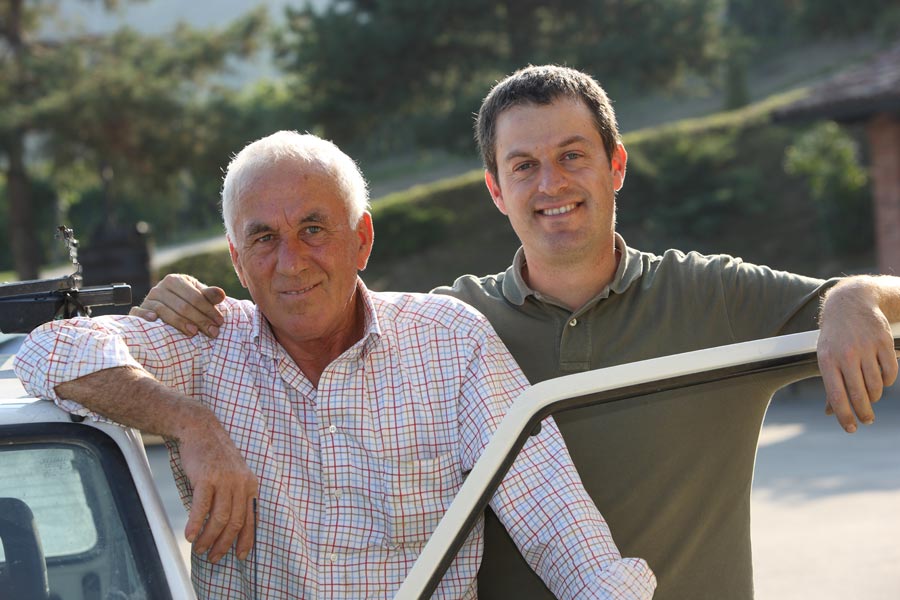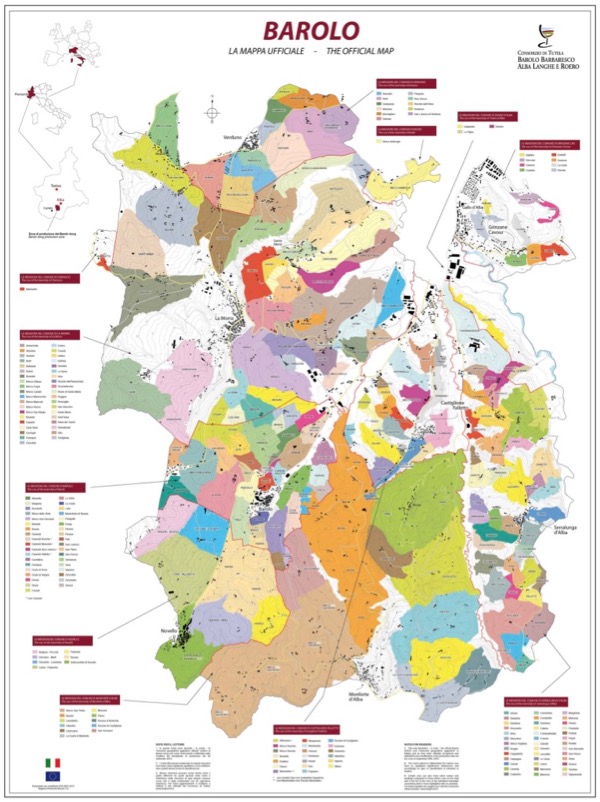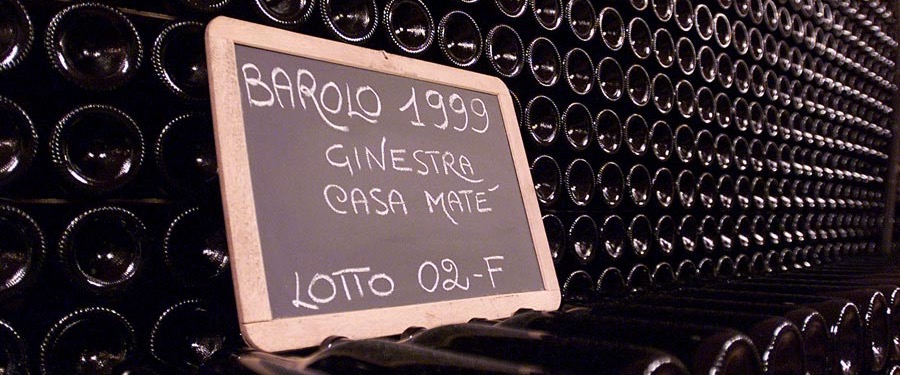Today we offer Elio Grasso’s 2016 Cru’s Ginestra Casa Matè and Chiniera, and, their Riserva Rüncot from 2013. All wines are in the country and ready to ship.
Elio Grasso’s 2016s are some of the most reticent wines I tasted. I would have to go back pretty far to find another vintage in which the wines are so taut and piercing in the early going. Gianluca Grasso gave his 2016s a whopping 60 days on the skins. As always, the wines are aged in cask, the exception being the Rüncot, which is aged in French oak. Readers will have to be especially patient with the 2016s.
Antonio Galloni
About Elio Grasso
The Grasso family is highly respected by other Barolo producers and has lived in the Langhe for centuries, but only started bottling their own wines in the late 70’s, converting themselves from a growers family to wine producers. Great efforts were made in modernising and replanting Vineyards with the simple goal to produce the best Barolo possible from their Land. A jewel of an estate, with Gavarini Chiniera and Ginestra Casa mate vineyard sites in their holdings in Monforte. These wines sit at the very top of the pyramid and Elio and his son Gianluca, continue to release beautifully perfumed and structured Barolo, both in a traditional style and Runcot as the more modern wine. Great expressions of Monforte terroir; these examples of Barolo are as honest as you can find.

Gianluca and his sister Francesca are excited about the 2016 Vintage, saying that even Elio was unable to remember a great Vintage like this. The wines showed as beautiful as ever you can see the richer more textural clay soil influence in the Casa Matè, while Vigna Chiniera really ‘feels’ like Lime Stone.
Stephen Tanzer explores the Grasso vintages from 2004-2007 with Gianluca Grasso
The Vintages
2016
2016 has come at just the right time. We have a number of winemakers with incredible experience and wine wisdom. The vineyards in Barolo are in the best condition they’ve been in with incredible detail going into their care.
Combined we have a situation where vignerons are in the best possible position to make the most of the great fruit yielded by the 2016 harvest!
When you compare the 2015 & 2016 vintages you see the difference between a warmer vintage with a shorter ripening period and a cooler one with the longest ripening period in memory.
Nebbiolo responds beautifully to a cooler longer ripening. Once it reaches sugar level high enough to make a wine around 14-14.5% alcohol the sugar levels stop increasing, it tends to hold its acid and the tannins so important to the insane mouthfeel of Nebbiolo ripen and increase in depth.
Such vintages tend to offer wines with more perfume, energy, and, vitality.
The 2016 vintage was one of the longest-lasting in recent years. Early winter was dry and mild, however from the end of February through March, the temperatures dropped with plenty of rain, providing good reserves of water. The “late” cold delayed the vegetative cycle, and spring proper also started wet with average daytime temperatures but low overnight minimums, helping retain good health. This phenological delay continued until the end of the summer, which began slowly but extended until the end of September. The white harvest ran from September 5th to 20th, with the wines showing excellent aroma and good acidity due to cooler summer temperature peaks. The red harvest began immediately after with Dolcetto, followed without a break to the middle of October with the Barbera and Nebbiolo. 2016 was a very good vintage for Dolcetto, but even more so for Barbera, which acquired excellent levels of sugar over a long period of stable conditions, while maintaining the varietal’s typically good acidity. Nebbiolo also achieved good phenological ripeness, a direct result of the perfect warm, sunny conditions of the second half of September. Whilst it is still early, the 2016 vintage wines display excellent balance, generous aromatics and great structure, and in some cases lower alcohols, compared to 2015. 2016 promises to be a vintage which will be talked about for a long time to come!
2016 is already being mentioned in the same breath as 2004 & 1990!
2013
The 2013 harvest occurred approximately 15 days later than the average over the past 10 years, finishing early in November with the last bunches of nebbiolo. The season began slowly with cool temperatures in March and April, and very wet conditions in April and May. Despite a very positive summer and good weather between véraison and ripening, the vine was unable to completely make up the sluggish start. Good berry size and water reserves resulted in larger, heavier and more compact bunches that in recent years. The early ripening dolcetto wines are fresh, fragrant and beautifully expressive. The cooler daytime temperatures and shorter period of intense heat resulted in lighter bodied barbera wines with firmer acids. Nebbiolo is the variety that benefited most from the high day-time temperatures recorded in September and October, which allowed the development of its full phenolic and aromatic profile ideal for ageing. Wherever green harvesting and stripping of the leaves were carried out at the right time and in the right way, 2013 is an excellent vintage of well-structured, long-lasting wines.
Where in the World is Elio Grasso?
Elio Grasso is based in the Commune of Monforte d’Alba, known for it’s powerful, structured and, long lived wines.

This 3D flyover is Epic covering each of the communes you can see just how varied and extreme the aspect of each vineyard is and how in the space of a few metres just how dramatically the change.
About the Wines
2016 Barolo Ginestra Casa Matè

Grape: Nebbiolo
First vintage: 1978
Aspect and height above sea level: south-facing, 300-350 metres
Soil type: moderately loose-packed, slightly clayey, limestone-based
Vine training system and planting density: Guyot-trained at 4,500 vines per hectare
Average age of productive vines: around 40 years
Harvest period and method: second 10 days of October, manual harvest
The vinification procedure for Barolo Ginestra Casa Matè involves alcoholic fermentation in temperature-controlled stainless steel tanks, with daily pumping over. After completing malolactic fermentation, the wine matures in 25-hectolitre barrels of Slavonian oak. Bottling normally takes place in August. The Barolo Ginestra Casa Matè then stays in the binning cellar for 8-10 months before release.
Ample and creamy on the palate, with tremendous depth, the 2016 Barolo Ginestra Casa Matè is super impressive, even in the early going. Next to the Gavarini Chiniera, the Ginestra Casa Matè is a Barolo of textural resonance and volume. Black cherry, plum and a range of balsamic notes infuse the 2016 with tons of character. The is one of the real standouts of the year.
2016 Barolo Gavarini Chiniera

Grape: Nebbiolo
First vintage: 1978
Aspect and height above sea level: south-facing, 350-400 metres
Soil type: moderately loose-packed, slightly sandy, limestone-based
Vine training system and planting density: Guyot-trained at 4,500 vines per hectare
Average age of productive vines: around 35 years
Harvest period and method: second 10 days of October, manual harvest
The vinification procedure for Barolo Gavarini Chiniera involves alcoholic fermentation in temperature-controlled stainless steel tanks, with daily pumping over. After completing malolactic fermentation, the wine matures in 25-hectolitre barrels of Slavonian oak. Bottling normally takes place in August. The Barolo Gavarini Chiniera then stays in the binning cellar for 8-10 months before release.
The 2016 Barolo Gavarini Chiniera is a vibrant, massively tannic, austere wine, the likes of which I have never tasted here before. Vertical and explosive in the glass with tons of pure power, the 2016 Gavarini Chiniera is a gorgeous Barolo that is going to need a number of years to be at its best. Swaths of tannin wrap around a core of sweet red cherry fruit. White pepper, mint, orange peel and floral notes develop a bit later, but the 2016 remains reticent and inward, with brilliant acids and tannins that dominate today. The 2016 is a striking wine, but it is going to require considerable patience.
2013 Barolo Rüncot

Grape: Nebbiolo
First vintage: 1995
Aspect and height above sea level: south-facing, 300-350 metres
Soil type: moderately loose-packed, slightly clayey, limestone-based
Vine training system and planting density: Guyot-trained at 4,500 vines per hectare
Average age of productive vines: about 30 years
Harvest period and method: second 10 days of October manual harvest
The vinification procedure for Barolo Rüncot includes alcoholic fermentation in temperature-controlled stainless steel tanks, with daily pumping over. After completing first alcoholic, then malolactic fermentation, the wine mature in barriques of French oak. Bottling normally in August, the Barolo Rüncot then stays in the binning cellar for 18-24 months before release.
The 2013 Barolo Riserva Rüncot is a stunning beauty. Vibrant and powerful in the glass, the 2013 shows all of the classical austerity of this late-ripening vintage along with the extra kick of richness that comes from three and a half years in 100% new French oak. Dark macerated cherry, tobacco, spice, licorice and dried flowers flesh out in a wine that is powerful, sumptuous and full-bodied to the core. Grasso will release the 2013 in 2020, a year later that is typical, but that probably won't be enough for this wine to be fully expressive. Rüncot is a wine that needs time to fully emerge, but the 2013 is incredibly promising even in the early going. Wow!
If any Italian wine from this decade can undeniably be called a reserve, it is the 2013 Barolo Riserva Rüncot. This wine was not made in 2011, 2012, 2014, 2017 nor 2018. (The 2013 vintage will be released commercially in February of 2020, and this is the wine's first official review.) Gianluca Grasso holds the precious bottle I tasted from as if it were a newborn child. This vintage saw a relatively long growing season, and it offers greater fruit density, structure and acidity than the last edition that was made, the 2010. There is more vibrancy here and a true sense of energy brimming right there under the surface. The wine goes through 45 days of extended maceration post-fermentation and then a solid seven years of aging between oak and bottle. The resulting Riserva Rüncot has a stunning bouquet that is all violets and prunes, followed by a classic palate of minerals, herbs, cinnamon and delicate wafts of white truffle. This wine tells a story from nose to finish, like a flashing film reel. Fewer than 5,000 bottles were made. This is a crowning achievement for the hard-working and passionate Grasso family, led by father Elio and son Gianluca. Congratulations.




You must be logged in to post a comment.